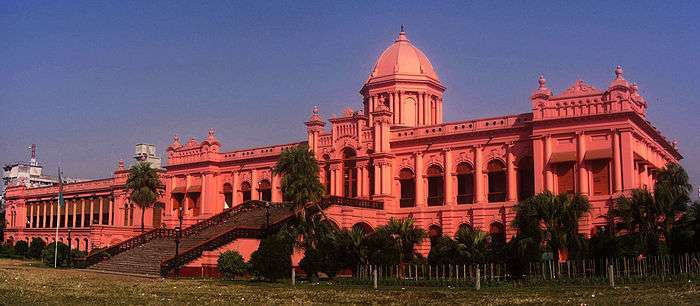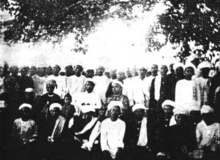Bohmong Circle
The Bohmong Circle (Burmese: ဗိုလ်မင်းထောင်) is one of three hereditary chiefdoms (or "circles") in the Chittagong Hill Tracts of modern-day Bangladesh. The jurisdiction of the Bohmong Circle encompasses parts of Bandarban District. The chiefdom's members are of Marma descent and are known as ragraisa.[1] Most inhabitants of the Mong Circle settled in the south during a migration wave from the Kingdom of Mrauk U (modern-day Arakan State in Myanmar) between the 16th and 18th centuries, while inhabitants of the other Marma chiefdom, the Mong Circle, settled in the northwest and are known as phalansa (ဖလံသား).[1]
| Part of a series on |
| Zamindars of Bengal |
|---|
 |
|
Central Bengal Present Divisions: Dhaka and Mymensingh
|
|
Eastern Bengal Present Divisions: Chittagong and Sylhet
|
|
Present Divisions: Rangpur and Rajshahi
|
|
|
|
|

Leadership
The Bohmong Circle is led by a hereditary chieftain called a "raja." The Bohmong chieftains appoint and oversee headmen called mouza and village chiefs called karbaris.[2] The incumbent chieftain is Chaw Prue (ချောဖြူ), an engineer by training.[3] The Bohmong chieftain leads an annual three-day festival called "raj punnah," which has been held since 1875.[4][5][6] The Bohmong chieftain also sits on the Advisory Council for the Ministry of Chittagong Hill Tracts Affairs and the Bandarban Hill District Council.[7]
History
The Bohmong chieftains claim descent from Tabinshwehti and Nanda Bayin of the Toungoo Empire.[8][9] During British rule, the Chittagong Hill Tracts were administratively divided into three circles in 1884, namely the Chakma Circle, the Bohmong Circle, and the Mong Circles, each presided over by a hereditary chief from the Chakma and Marma peoples.[10][11] The circles were codified into law with the Chittagong Hill Tract Regulations, 1900, eased revenue collection and administrative burdens on British authorities by delegating tax collection, land administration management and social arbitration responsibilities to the chieftains.[12][11] In 1901, the Bohmong Circle extended 2,064 square miles (5,350 km2).[13] This administrative structure remained in place until 1964, when the introduction of local self-government abolished the special status of these circles and brought local administration under the control of the central government.[14]
References
- I, Fonkem Achankeng (2015-09-28). Nationalism and Intra-State Conflicts in the Postcolonial World. Lexington Books. ISBN 9781498500265.
- "Saching Prue new Mong King". The Daily Star. 2009-01-18. Retrieved 2018-09-19.
- "Raj Punnah begins December 21". The Daily Star. 2016-12-02. Retrieved 2018-09-19.
- "Raj Punnah begins Dec 21". The Daily Star. 2017-11-23. Retrieved 2018-09-19.
- "Full implementation during this govt". The Daily Star. 2017-12-22. Retrieved 2018-09-19.
- "Raj Punnah fest begins in hills". The Daily Star. 2015-12-19. Retrieved 2018-09-19.
- "Chittagong Hill Tracts Peace Accord" (PDF). 1997-12-02. Archived from the original (PDF) on 2018-11-21. Retrieved 2018-09-19.
- "The history of Raja of the Bohmong Circle". Retrieved 2018-09-19.
- Gardens, The Horniman Museum and. "Five Go Collecting: Kingly Swords". Horniman Museum and Gardens. Archived from the original on 2018-09-19. Retrieved 2018-09-19.
- Hutchinson, Robert Henry Sneyd (1906). An Account of the Chittagong Hill Tracts. Bengal Secretariat Book Depot.
- Kundu, Debasish; Samadder, Mrinmoy; Khan, Ashrafuzzaman; Shajahan Naomi, Sharin (2011-01-04). State of Justice in Chittagong Hill Tracts: Exploring the Formal and Informal Justice Institutions of Indigenous Communities (Report). BRAC.
- "Bandarban wears festive look as Rajpunyah starts". The Daily Star. 2010-01-15. Retrieved 2018-09-19.
- Hutchinson, Robert Henry Sneyd (1906). An Account of the Chittagong Hill Tracts. Bengal Secretariat Book Depot.
- Zaman, M. Q. (1982). "Crisis in Chittagong Hill Tracts: Ethnicity and Integration". Economic and Political Weekly. 17 (3): 75–80. JSTOR 4370578.